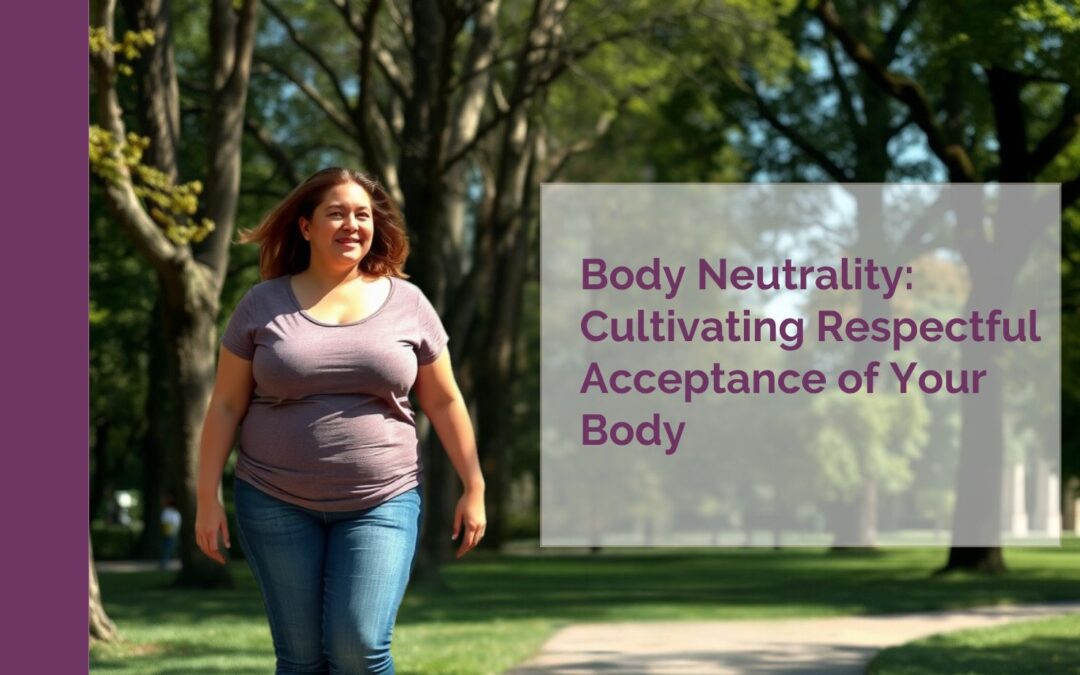Are you struggling to feel at peace with your body in a world hyper-focused on appearance? Body neutrality offers a gentler approach, encouraging a non-judgemental acceptance of your body just as it is.
In this post, you’ll discover how body neutrality can help you build a respectful, non-judgemental relationship with your body. By the end, you’ll walk away with practical insights into embracing a neutral mindset that values functionality over aesthetics and self-acceptance over perfection.
What is Body Neutrality?
At our clinic, body neutrality is a core part of our support for clients in building a respectful relationship with their bodies. To us, body neutrality means understanding that your worth and identity aren’t defined by how you look. Instead, it’s about recognizing and respecting your body for its functionality, capabilities, and intrinsic value.
Our approach is centered on treating the body with kindness and recognizing its essential role in your life—without needing to love or celebrate its appearance. We work with clients to reclaim mental space from appearance-based judgments, helping them focus on what their body enables them to do, rather than how it looks. By moving beyond societal beauty ideals, body neutrality allows for a grounded relationship with the body, one rooted in acceptance and respect without the pressure to feel strongly positive or negative about appearance. In essence, it can be an accessible, realistic approach that helps you experience your body as it is, free from comparison or self-objectification.
Body Neutrality vs. Body Positivity: Key Differences
While both body neutrality and body positivity aim to cultivate healthier relationships with our bodies, they do so in distinct ways.
Body Positivity promotes celebrating and loving your appearance, encouraging you to find beauty in every part of yourself. The movement often embraces affirmations, encouraging people to love their bodies regardless of societal standards. For some, this approach can be empowering, but it also places a continual emphasis on appearance, which may feel challenging on days when self-love feels out of reach.
Body Neutrality, on the other hand, doesn’t demand that you love how you look. Instead, it promotes a balanced acceptance and respect for your body as it is. This approach focuses on what your body does—its abilities, functionality, and how it supports you daily—rather than how it looks. It allows you to appreciate your body’s role in your life without the pressure to feel positive about your appearance.
Why Body Neutrality Can Feel More Sustainable
For many, body neutrality offers a more sustainable approach. The pressure to maintain a positive outlook on appearance can feel overwhelming, especially in a culture saturated with beauty standards. Embracing a body-neutral mindset recognizes that we don’t need to love our appearance every day to live a fulfilling life. Instead, it encourages a more grounded, accessible mindset, where respecting and caring for the body as it is becomes the goal, without the need for constant self-celebration.
Benefits of Practicing Body Neutrality
Here’s how adopting a body-neutral mindset can positively impact your mental and physical health.
Improved Mental Health
When you reduce your focus on appearance, you may find a drop in self-criticism and anxiety. A more relaxed relationship with your body can help you focus on overall well-being, fostering a positive, sustainable self-image.
Resilience Against Societal Pressures
In a world that emphasizes physical beauty, body neutrality offers an alternative approach. When you focus on your body’s abilities, you become less vulnerable to media pressures and beauty ideals, helping you feel more comfortable in your own skin.
Accessible for Those with Body Image Challenges
If you struggle with body positivity, body neutrality can be a more realistic alternative. Rather than striving to feel great about your appearance, you can work toward respecting and accepting your body as it is, helping to build a more sustainable sense of self-worth.
Health Practices Based on Function
Body neutrality encourages you to prioritize physical activities based on how they make you feel rather than how they’ll make you look. Whether you’re increasing stamina, boosting strength, or managing stress, the focus remains on supporting physical health without appearance-driven goals.
How to Practice Body Neutrality
Wondering how to start? Here are some simple practices that can help.
Shift Your Language
Adjusting the way you talk about your body can help you embrace a body-neutral mindset. Instead of saying, “I love my toned arms,” or “I don’t like my stomach,” try, “My arms let me carry things,” or “My stomach digests food to nourish me.” These subtle changes shift focus from appearance to function.
Practice Gratitude for Your Body’s Abilities
Take a few moments each day to appreciate what your body does for you. Thank your legs for taking you where you need to go or your hands for helping you type, cook, or create. This gratitude practice builds a foundation of body respect.
Tune Into Physical Sensations
Notice how your body feels without attaching any judgments. Whether it’s during a meal, exercise, or rest, pay attention to sensations like satisfaction, energy, or relaxation. This awareness helps you appreciate your body’s function rather than its looks.
Avoid Self-Objectifying Behaviors
Minimize habits like frequently checking yourself in the mirror or weighing yourself. Reducing these behaviors can help you focus on how you feel and what you can do, instead of getting caught up in appearance.
Set Goals Focused on Function
If you want to set health goals, consider focusing on how they’ll help your body function. Choose goals like improving flexibility, increasing stamina, or managing stress. These goals support your health without focusing on appearance.
Limit Beauty-Centric Media
Reducing exposure to media that promotes narrow beauty standards can make it easier to embrace body neutrality. Curating your media environment to include content that celebrates function over form can support your journey.
Seek Body-Neutral Support
Body neutrality is a growing movement, and there are communities and resources dedicated to this mindset. Joining a group or reading body-neutral materials can help reinforce the focus on your body’s abilities.
Common Misconceptions
As you start practicing body neutrality, it can be helpful to understand some common misconceptions.
Misconception: Body Neutrality Means Ignoring Your Body
Body neutrality isn’t about neglecting your body; it’s about treating it with respect and focusing on function. You can acknowledge and care for your body without fixating on looks.
Misconception: Is Only for People with Positive Body Image
Body neutrality is especially helpful for people who struggle with body image. It provides an accessible approach, allowing you to feel comfortable in your body without needing to feel positive about it.
Misconception: Body Neutrality Conflicts with Health Goals
Body neutrality aligns well with health goals. It emphasizes goals that enhance functionality, such as strength or stamina, without focusing on aesthetics.
Misconception: You Can’t Care About Your Looks
Body neutrality doesn’t mean you can’t enjoy your appearance. It simply encourages a balanced perspective, where appearance isn’t your main measure of self-worth.
Explore More: Enhancing Your Relationship With Food
Are you ready to take the next step?
Embracing body neutrality can be a powerful step toward a healthier, more respectful relationship with your body. By shifting focus away from appearance and toward acceptance, body neutrality offers a sustainable path to self-respect and well-being. If you’re ready to take the next step, consider booking a session with a dietitian or therapist who can guide you in developing a neutral relationship with your body and support your journey toward true self-acceptance.
GET IN TOUCH

 ABOUT US
ABOUT US BOOK AN APPOINTMENT
BOOK AN APPOINTMENT LOCATION & CONTACT US
LOCATION & CONTACT US EMPLOYMENT
EMPLOYMENT



 HOW TO REFER A PATIENT
HOW TO REFER A PATIENT ALN ACADEMY
ALN ACADEMY VIRTUAL GRAND ROUNDS – EATING DISORDER CASES
VIRTUAL GRAND ROUNDS – EATING DISORDER CASES CLINICAL NUTRITION MENTORSHIP & SUPERVISION
CLINICAL NUTRITION MENTORSHIP & SUPERVISION




